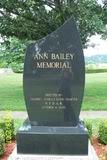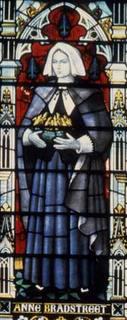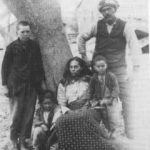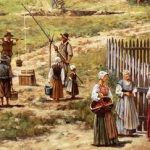American Frontier Woman
Anne Hennis Trotter Bailey is known as Mad Anne for her acts of bravery and heroism that were considered to be somewhat eccentric for a woman of her time. She worked as a frontier scout and messenger during the Revolutionary War.
Anne Hennis was born in Liverpool England in 1742. She was formally educated and learned to read and write. Both of her parents had died by the time she turned 18; Ann was poor and had a hard time earning enough money to survive. When she was 19, she sailed to America, and lived with relatives in Virginia near Staunton in the Shenandoah Valley. Anne married Richard Trotter, a seasoned frontiersman and experienced soldier, in 1765, and had one son named William.
As more and more people moved West, fights broke out between settlers and the Native Americans who already lived in the area. The Governor of Virginia organized border militia to help calm the area. Richard Trotter joined this militia.
At the Battle of Point Pleasant on October 19, 1774, Native Americans under the Shawnee Chief Cornstalk attacked the Virginia militia, hoping to halt their advance into the Ohio Country. After a long and furious battle, Cornstalk retreated. The Virginians, along with a second force led by Lord Dunmore, the Royal Governor of Virginia, then marched into the Ohio Country and compelled Cornstalk to agree to a treaty, ending the war.
Called the first battle of the American Revolution by some, this conflict prevented the Native Americans from becoming allies to the British. Although the settlers won the battle, there were massive casualties on both sides. Richard Trotter was killed in that battle.
Immediately upon learning of her husband’s death, Anne left her young son in the care of neighbors, dressed in the garb of a frontiersman, and set out to avenge her loss. She became known, to whites and Indians alike, as Mad Anne. She rode from one recruiting station to another, making appeals to all she met to volunteer their services to the militia in order to keep the women and children of the border safe, to fight for freedom from the Indians, and later the British.
From Staunton, Virginia, to what is now Charleston, West Virginia, and Gallipolis, Ohio, Anne was an unusual sight – clad in buckskin leggings, petticoats, heavy brogan shoes, a man’s coat and hat, a hunting knife in a belt around her waist, and a rifle slung over her shoulder – the embodiment of the pioneer spirit in the late 1700s.
Although Mad Anne primarily rode up and down the western frontier, she also recruited for the Continental Army, and delivered messages between various Army detachments during the Revolutionary War. She often traveled as a courier on horseback between Forts Savannah and Randolph, a distance of almost 160 miles. She was well known and respected by the settlers along the route.
On her rides Bailey often came across a group of Shawnee Indians. In one such encounter, Bailey was being chased by them and about to be caught when she jumped off her horse and hid in a log. Though they looked everywhere for her and even stopped to rest on the log, they could not find her. They gave up and stole her horse. After they left, Bailey came out of the log and during the night crept into their camp and retrieved her horse.
When she was far enough away, she began to scream and shriek at the top of her voice. The Shawnee thought she was possessed and could not be injured by a bullet or arrow. After this event, they saw her often, but they feared her and only watched her from afar, making her relatively safe living in the woods.
After several years living on her own, Anne met John Bailey, a member of a legendary group of frontier scouts called the Rangers, who were defending the Roanoke and Catawba settlements from Indian attacks. He seemed to enjoy Mad Anne’s rough ways, and they were married November 3, 1785.
In 1787, along the Kanawha River at the mouth of the Elk River, a blockhouse was built. Later it would be called Fort Lee in honor of Virginia’s Governor Henry Lee, father of Robert Edward Lee of Civil War fame some seventy-five years later. It was to this fort that John Bailey went on duty, taking with him his now famous, gun-toting, hard-riding bride.
In 1788, John Bailey began duty at Fort Clendenin, where there was more conflict between the settlers and Native Americans. Anne Bailey began working for the settlers as well, riding on horseback to warn them of impending attacks.
In 1791, Anne Bailey singlehandedly saved Fort Lee (now Charleston, West Virginia) from certain destruction by hostile Indians with a three-day, 200–mile round trip to replenish their supply of gunpowder. After hours of riding, she reached Fort Savannah at Lewisburg. There, gunpowder was quickly packed aboard her horse and one additional mount, before she reversed her direction and galloped back to Fort Lee.
With Anne’s return, the siege was lifted, the attackers repulsed. For her bravery Anne was given the horse that had carried her away and brought her safely back. The animal was said to have been a beautiful black, sporting white feet and a blazed face. She dubbed him Liverpool, in honor of her birthplace. Anne Bailey was forty-nine years old when she made this famous ride.
Anne became a legend among the other settlers, and she was always welcome in their homes. A poem was written in 1861 by Charles Robb called Anne Bailey’s Ride.
When John Bailey died in 1802, Anne gave up her home and lived in the wilderness for over 20 years. She visited friends occasionally, but often slept outside. A cave near Thirteen Mile Creek was said to be her favorite place. Bailey continued to messenger supplies for the settlers throughout the area. She made her last trip to Charleston in 1817, at age 75.
Again a widow, and in her late fifties, Anne went to live with her son but her love for riding and of the wilderness had not ceased. For many years afterwards she could be seen riding from Point Pleasant to Lewisburg and Staunton, carrying mail and as an express messenger.
In 1818 Anne moved with her son and his family to his new farm in Gallia County, Ohio. Instead of asking her to stay with his family, her son built her a cabin nearby so she would still feel independent.
In 1823, Ann Bailey was interviewed by Anne Royall, a local reporter. When speaking of her adventures and bravery she said, “I always carried an ax and auger, and I could chop as well as any man… I trusted in the Almighty… I knew I could only be killed once, and I had to die sometime.”

Image: Anne Bailey Memorial
Point Pleasant, West Virginia
Anne Hennis Trotter Bailey died at Gallipolis, Ohio, November 22, 1825, at the age of 83. She was buried in the Trotter Graveyard near her son’s home, and her remains rested there for seventy-six years.
On October 10, 1901, her remains were re-interred in Monument Park in Point Pleasant, under the auspices of the Colonel Charles Lewis, Jr. Chapter of the D. A. R.
SOURCES
Anne Bailey
Battle of Point Pleasant
Anne Trotter Hennis Bailey







Wonderful true pioneer woman that is a Legend!!
Love the true stories of our founding Wonen !!